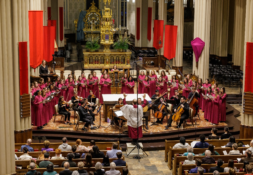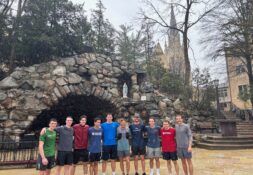Here’s to hoping it’s not a Game of Thrones rip-off
Tolkien enthusiasts wait with bated breath in anticipation of Amazon’s forthcoming The Lord of the Rings TV series. Production of the series–the rights for which came at a hefty 250 million dollars– is expected to begin later this year. Earlier this month, Amazon released five maps relevant to the series, effectively quashing rumors that the show will focus on the life of Aragorn.
One map shows the land of Rohan labeled Calenardhon, which would mean that the show deals with events at least 500 years prior to the deeds of The Lord of the Rings. Another map shows Lothlórien labeled as Laurelindórenan, the original, far older name for the land ruled by the elf-queen Galadriel and her husband Celeborn.
The second to last map includes names from early in the Third Age, such as Minas Ithil and Minas Anor. Minas Ithil is known as Minas Morgul in The Lord of the Rings as it is later conquered by the forces of Sauron. Minas Anor is known as Minas Tirith at the time of the War of the Ring. The last map is perhaps the most interesting because it shows the island of Númenor, which is a setting in The Silmarillion and indicates that parts of the Amazon series will take place in the Second Age.
One unfamiliar with Tolkien and his fans may be surprised to hear that many readers are nervous rather than excited in their anticipation of the series. But those who have read The Lord of the Rings will likely share the sense of fear that the ethereal beauty, underlying nostalgia, and Catholicism of Tolkien’s work will be all but lost in this production.
The last major adaptation of Tolkien’s work, The Lord of the Rings film trilogy directed by Peter Jackson, is remembered by many as a triumph of adaptation, winning no fewer than 17 Academy Awards and being nominated for 30. The film series was one of the most ambitious of its time, with 1 in every 160 New Zealanders aiding in the production. The Amazon series is anticipated to be certainly as ambitious, if not more ambitious than Jackson’s adaptation.
The film series was remarkably adherent to the themes of the books, sometimes going far beyond the books to evoke distinctly Catholic themes. Through minor additions involving shots of Aragorn touching his forehead and lips, to a new resurrection plot arc for Aragorn, the films chose to ignore the subtlety of Tolkien’s work in order to make the Catholic character practically impossible for the careful viewer to miss.
However, one cannot eschew a discussion of how Jackson’s adaptation missed the mark. Major changes to the character Faramir, distortion of the dynamic between Frodo, Sam, and Gollum, and the removal of the Scouring of the Shire episode frustrated purists. The aversion to unnecessary violence and the emphasis on mercy in the books was noticeably neglected in the films.
Even so, the explicit openness to the Catholic themes on the part of the directors was no less than a miracle in Hollywood. Even Tolkien’s nostalgia and desire to “reignite an old flame” in the world was evident in the films.
But the world of high fantasy in movies and media has certainly changed in the past fifteen years. The massive success of the high fantasy series, Game of Thrones, is bound to have a lasting impact on all future fantasy series. Furthermore, Peter Jackson has confirmed that he will not be involved in the production of the Amazon series. One cannot avoid suspecting that Amazon’s desire to create this series was prompted by the financial success and critical acclaim of Game of Thrones. Furthermore, Amazon’s apparent decision to focus on the Second Age of Middle Earth gives them relatively free reign in terms of characterization and thematic development, and they cannot help but be influenced by the themes of Game of Thrones. However, The Lord of the Rings is not primarily a tale of political intrigue or medieval realism, and the themes of Game of Thrones are largely incompatible with Tolkien’s vision.
The thematic differences between Tolkien’s and Martin’s respective works are stark. Martin presents characters where corruption is intrinsic and leaks from their very souls. Tolkien’s world is one where an external evil gradually wears down the soul’s natural inclination toward good, until the soul becomes open to evil. The Lord of the Rings is not lying to its readers about the reality of internal corruption and the moral weakness of human beings, rather, it espouses a sanctifying grace that literally saves us from the fires of Mount Doom.
The perspectives of villainous characters are noticeably absent from The Lord of the Rings. Tolkien does not wish for us to dwell too long on the moral complexity of Saruman, rather, he intends for us to identify the virtues of his heroes and imitate them. The moral ambiguity and degrading vulgarity in Martin’s works stand in sharp contrast to the virtue ethics and transformative beauty of Tolkien’s legendarium.
Some may argue that the moral ambiguity of the characters in A Song of Ice and Fire is necessary as it more closely aligns to the problems of the real world. However, I believe Tolkien’s legendarium provides us with moral guidance that Martin’s mythology lacks. The world does not need moral relativism disguised as moral realism. We witness the moral corruption of human beings every day. Rather, the world needs virtues to seek with fervor, a mountain to ascend, and great heroes to emulate. The world needs hagiography, and Tolkien’s work serves as a necessary substitute for a world that ignores saints and dismisses virtue.
The corruption of Tolkien’s world is a real and present danger in the minds of devoted readers. The modern world has largely failed to twist and degrade Tolkien’s works through adaptations. But we have no reason to believe that it will remain that way, as it is likely that this new series will not remain faithful to the themes of Tolkien’s legendarium.
However, we should not let this prospect tear us away from our hope that Tolkien’s works will “reignite an old light” in the world. We can still hope that even a twisted, maltreated version of Arda will draw new readers to the transformative splendor of Tolkien’s legendarium.
Maria is a first year majoring in the Program of Liberal Studies. She likes raccoons, the smell of old books, and the concept of living in a cottage in Ireland. Contact her at mkeller7@nd.edu.






Leave a Reply